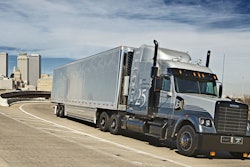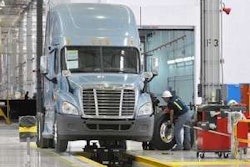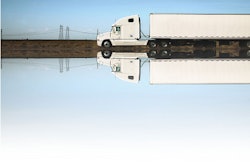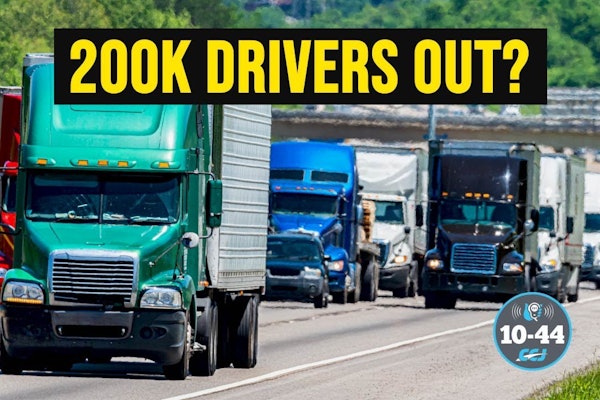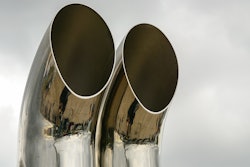The NTEA Work Truck Show kicked off Monday, March 5, in Indianapolis with the Green Truck Summit as keynote speaker U.S. Energy Secretary Stephen Chu discussed general petrochemical, geopolitical and climate trends and how those factors will affect the North American commercial truck industry and transportation sector in coming years. Chu said the Obama administration is taking a proactive role in working with American private businesses to drive innovation in the commercial truck industry with an overall goal of increasing fuel efficiency and productivity while driving down both acquisition costs and ROI for new and alternative propulsion technologies.
Chu said the Department of Energy is taking a multifaceted approach to America’s energy needs with multiple overall goals: To reduce the pressure on families being squeezed by the cost of fuel; moderate or even eliminate wild spikes in the cost of fuel; and promote and encourage the development, acceptance and use of alternate fuel and powertrain technologies – and do all of this in a responsible manner that promotes the current economic recovery and sustained economic growth going forward.
Chu said DOE’s current efforts are wide-reaching and hope to positively boost fuel economy and reduce greenhouse gas emissions in a number of markets and applications from compact consumer automobiles to heavy-duty commercial trucks and trailers. The efforts range from aerodynamic initiatives to vehicle weight reduction through the use of new lightweight high-strength steel in automotive designs. “We know that for every 10 percent reduction in weight we can take out of a passenger car, there is a corresponding 7 percent increase in fuel efficiency,” Chu said.
At the same time, DOE is pioneering the use of vehicle and engine design using government-developed and funded supercomputers to accelerate the time-to-market for promising new technologies. Chu specifically touted the development of a new Cummins 6-liter diesel engine. “We have a much deeper understanding of engine design and operation today thanks to these supercomputers,” Chu said. “The question is how we can help American businesses and consumers operating in very competitive worldwide markets. One easy answer is the use of these supercomputers to simulate performance in cars, trucks, engines and tires the way we already do with aircraft like the new Boeing 787 Dreamliner. By doing so, we believe we can reduce design cycles by up to 50 percent and save companies a lot of money.”
Other DOE initiatives Chu highlighted include an increased emphasis on trailer aerodynamics, including new undertray aerodynamic systems designed to smooth airflow under a conventional 53-foot dry van, particularly under the trailer’s axles. In doing so, Chu said, studies have found fleets can increase fuel economy by another 5 to 10 percent in conventional longhaul applications.
In terms of emerging technology, Chu said that high U.S. reserves of natural gas make LNG and CNG fuel options a “no-brainer” for the trucking industry, but he noted that infrastructure is lagging and acquisition costs remain high, while the ROI for such systems is still in the 2- to 4-year range. “Our push here is to drive natural gas technologies to get to a point where acquisition costs drop by 30 or 40 percent and ROI falls down to 2 years or less for these vehicles,” he added. “Those efforts are being helped by the dramatic infrastructure enhancements already under way. By year’s end, there will be 275 new LNG fueling stations located every 150 miles or so along the country’s major trucking routes, with another 17 stations under construction.”
Looking toward long-term solutions, Chu said promising research indicates biofuels could become a viable option. Using this approach, Chu said, various forms of organic matter from fast-growing grasses to waste products can be mixed with yeasts and bacteria to create chemical reactions that yield chemicals similar in form and function to gasoline or diesel fuel. While stressing that these efforts are in the early stage and a long way from maturity, Chu said that research is far enough along and results encouraging enough to begin construction on a pilot plant to explore mass production of these fuels.
Electric vehicles remain a promising option for many urban fleets, Chu said, and recent battery developments are increasing the efficiency of all-electric vehicles considerably. “The current problem here is battery price,” Chu said. “Currently, we’re talking about $10,000 to $15,000 for battery systems for these vehicles. We’ve just seen the introduction of 400-kilowatt battery systems, which doubles the power density of electric drive vehicles. The Department of Energy’s focus going forward will be to reduce the cost of these battery systems from $600 per kilowatt hour, where we are today, to $150 per kilowatt hour by 2020.”
Chu said that as emerging nations burn more diesel and gasoline, diversity will become increasingly important for truck fleets in coming years. “Like fleet managers, I am unimpressed by technology for technology’s sake,” he said. “I firmly believe that the Department of Energy must do whatever it can to help manufacturers and fleets get to the point where any additional cost added to a vehicle to boost fuel economy must be paying for itself in 3 or 4 years. This is what we are focusing on when it comes to electric or hybrid vehicles or just plain better conventional diesel engines, and we hope that competition between companies helps feed this effort. In the last 3 to 5 years, we’ve seen a lot of progress from the private sector in partnering with us, and we hope to continue that trend moving forward.”



